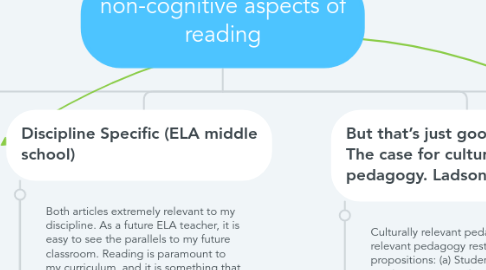
1. Reading: What else matters besides strategies and skills? Afflerbach et al
1.1. Examination of "other" factors, not limited to cognitive skill development. “we examine the role of four powerful, "other" factors: metacognition, engagement and motivation, epistemic beliefs, and self- efficacy, as they interact with strategy and skill, in students' reading development.” (pg. 440).
1.1.1. metacognition
1.1.2. engagement/motivation
1.1.3. epistemic beliefs
1.1.4. self-efficacy
1.2. “When students view reading as an opportunity to construct new knowledge, they use higher order thinking more frequently than students who believe that the goal of reading is to establish only a literal understanding of text to give back to the teacher.” (pg. 441).
1.3. According to Bandura (2006), "Unless... [students] believe they can produce desired effects by their actions, they have little incentive to act" (p. 170.)” (pg. 441).
2. But that’s just good teaching! The case for culturally relevant pedagogy. Ladson-Billings
2.1. Culturally relevant pedagogy. “Culturally relevant pedagogy rests on three criteria or propositions: (a) Students must experience academic success; (b) students must develop and/or maintain cultural competence; and (c) students must develop a critical consciousness through which they challenge the status quo of the current social order.” (pg. 160).
2.1.1. experience academic success
2.1.2. develop/maintain cultural competence
2.1.3. critical consciousness to challenge status quo
3. Overlap
3.1. Reading/literacy skills are more than cognitive development milestones (vocabulary, phonics, fluency etc.)
3.2. Importance placed on the individual student and their growth
3.3. Importance of not falling into the trap of homogenized learning, which often favors the cultural of the majority
3.4. Importance of creating a "buy in" with students. Teaching the why they should care.
4. Discipline Specific (ELA middle school)
4.1. Both articles extremely relevant to my discipline. As a future ELA teacher, it is easy to see the parallels to my future classroom. Reading is paramount to my curriculum, and it is something that I hope to instill a love for in each of my students. These articles made me consider the core of what I am helping them develop. Reading is more than a skill to be assessed on a standardized test, it is the key to opportunities in the future. Strong literacy skills help to create a future generation of leaders.
4.2. As a white woman, I often worry about how to create a culturally relevant atmosphere in my classroom that is respectful of the needs of my students. My personal learning experiences often mirrored my culture which can make me blind to how others might have felt in the classroom. Ladson-Billings article gave specific examples for classroom lessons to consider.
4.2.1. “Instead of railing against the supposed evils of rap music, Hilliard allowed her second-grade students to bring in samples of lyrics from what both she and the students determined to be non-offensive rap songs. Students were encouraged to perform the songs and the teacher reproduced them on an overhead so that they could discuss literal and figurative meanings as well as technical aspects of poetry such as rhyme scheme, alliteration and onomatopoeia.” (Ladson-Billings, pg. 161).
4.3. The idea of metacognition really hit me. Metacognition influences reading development in many ways. First, when students are aware of why they are reading, they have a more active role. The read and repeat information method does not build of skills that students need in order to become strong readers.
4.3.1. “Metacognition influences students' reading achievement, as students proactively set goals, select and use strategies, and self-monitor the effectiveness of their reading to achieve goals (Zimmerman, 2008). When students' engagement and motivation are strong, reading instruction improves students' reading comprehension (Guthrie, Wigfield, & You, 2012).” (Afflerbach et al, pg. 441).
